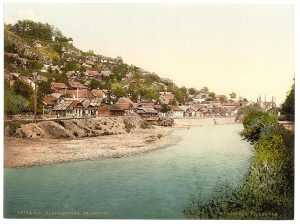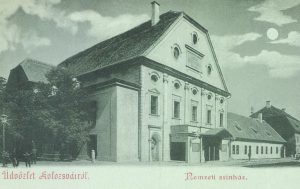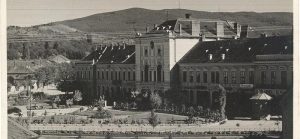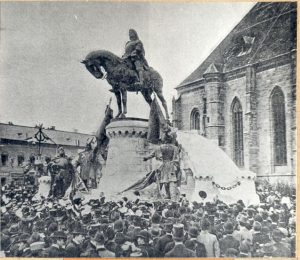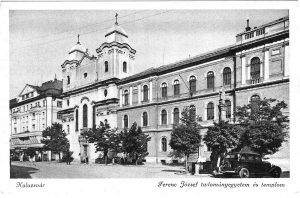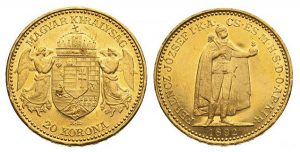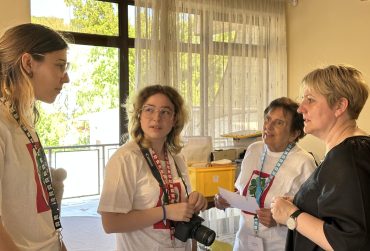In preparing this study, I used the paper of Lajos Katona: The History of the Institute of the Sightless in Kolozsvár between 1900 and 1920 as a source work. This paper has a certain historical value, although it was not published. The author was teacher of Mathematics from 1963 to 2003.
Our story begins with the death of the Hungarian Queen Elisabeth on September 10, 1898 at Geneve, Switzerland, who was stabbed in the heart by an Italian anarchist named Luigi Lucheni. The death of the beautiful Empress Sissi also shook Hungary deeply, as after many centuries she was the first queen to turn to the Hungarian nation with love and deep sympathy
Szvacsina Géza, the Major of Kolozsvár is writing about the beginnings (Szvacsina Géza: Report on the first year of activity of the Institute for Sightless in Kolozsvár, 1901): “The thought stalled as the devastating news ran through the country that our majestic queen, the protective angel of Hungary, our beloved Queen Elisabeth had been the victim of a murderous assassination attempt on September 10, 1898 in Geneva. The public of the free Royal city of Kolozsvár held an extraordinary general meeting the following day Sunday, at 4 p.m., and issued the No. 393 Decision, which stated, with the utmost grace and resemblance, that in the memory of the unforgettable great Queen a foundation will be established and entrust its detailed submission to the city Council (…) The City Legislative Committee in it’s Decision No. 480 in December 28, 1898, stated that in the memory of the late Queen Elisabeth, – with the aid of the state and the city – an Institute for the Sightless will be established (…) At the general assembly on April 4, 1899, it has been established the program of the foundations of the institute, and also at the same assembly it has been decided to count the teaching-age sightless children in the cities and counties of the eastern part of the country (…) The list of the teaching aged sightless children from the Eastern part of the country was completed in September 10, 1899 (…) This is a sorrowful statistic – Szvacsina was writing – because it is about 470 sightless, of whom only 38 received barely countable home education, but the other 432 children are left in a completely neglected state of their pitiful fate”. Subsequently, 175 blind children under the age of 14, who could be suitable for education in Kolozsvár, were selected, and an official notice was sent to their parents. These are the children who had no other disabilities, than blindness.
The city assembly in December 22, 1899 approved all the proposals regarding the establishment and functioning of the Institute for Sightless, issued by the supervisory board, and authorized it to rent a suitable place. The statute of the Institute was approved by the Minister of Religion and Public Education in March 27, 1900. On June, 25, the general assembly of the city acknowledged, that a subsidy of 3000 crowns per year was determined and earmarked for the Institute in the state budget, and the Minister of Culture, dr. Gyula Wlassics promised the nomination of the professional teaching staff. Thus, on October 15, 1900, the National Institute for the Sightless enrolled ten sightless student and opened in Honved street in Kolozsvár, under the leadership of Vuskits János. The operational framework approved by the Ministry of Religion and Public Education, consisting of 8 chapters and 17 paragraphs, defined the operational ground rules: “The aim of the institute is to train those admitted from the sightless children of any nationality and religion, belonging to the Hungarian State, according to the elementary school curricula, and to teach them to a craft.” The training lasted five years, of which three years included crafting education.
Thus, Institute for the Sightless, assisted by the State, first opened its doors in Kolozsvár on October 15, 1900, as a result of the decision and support of the Council of the Free Royal City of Kolozsvár. The school started its operation with 10 enrolled students in the tenement house at Kül Közép street (today Hovéd street/Calea Dorobantilor). Similar institutions opened in Bratislava in 1825, in Budapest in 1826, under the leadership of Károly Herodek, in Vienna in 1804, in Paris in 1784, under the leadership of Valentin Haüy, in Dresden in 1790 in Liverpool in 1890 in Edinburgh in 1793, in St. Petersburg 1806, in Amsterdam 1808, in Munich 1836, in Timisoara in 1901.
“Because the purpose of the Institute for the Blind is to be a Transylvanian and Compulsory School for the Blind in Transylvania, and as such, the Institute for the Blind is not a shelter, but a school where blind children receive regular schooling and in addition, they are trained in an industry that can earn their living “. (Statutes of the National State Aid Institute for the Blind in Kolozsvár – 1900
The rent of the Honvéd street property was financed by the city management of Kolozsvár, the salary of the specialist staff, housing and other costs were financed by the Budapest Ministry of Trade. The students were inmates, two-thirds of whom could not provide any financial support due to the social situation of their families, so their housing, meals and teaching had to be provided by the primary school. The families of three students, on the other hand, contributed 8 crowns a month to feeding the child.
Before taking a closer look at school education, let’s make a few distinctions:
- The National Institute of the Blind in Kolozsvár was not a state institution, it was “nationalized” during 1873 the Institute of the Pest of the Pest was – see Article XXXI of 1873 by which the state raises the responsibility and commitment to the national level with the assets of the institute.
- Although the institution of Kolozsvár received 3,000 crowns a year from the Hungarian state (as its name suggests, it was state-subsidized), as well as the expenses and salaries of the teaching staff, the company of the ministry (Ministry of Religion and Public Education),
- in addition to the state, the maintainers of the institution of Kolozsvár were the legislature of the free royal city (in today’s words, the municipality) and the benefactors of the institution. The National Association for the Protection of the Blind also plays a very important role, as exemplified by the establishment of the Transylvanian (Kolozsvár) Branch Association in 1907, under the leadership of the then director of the Cluj-Napoca Institute, Péter Schannen. embroiled in controversy over certain finances).
The Statutes were largely the same as those of the Institute for the Deaf in Kolozsvár, except for the sections on education. (The Institute for the Deaf was opened in Kolozsvár in 1888, and its Statutes of 1890 were finalized only in 1893, according to archive data). It is an interesting fact that the Statutes of the Institute for the Blind in Kolozsvár are being amended at the request of the Minister of Religion and Public Education in Budapest. Dr. Gyula Wlassics proposed two amendments, which were then adopted by the General Assembly of Kolozsvár:
a.) proposes to delete music education from the Articles of Association, because in his experience music does not provide a livelihood for the blind.
b.) children with multiple disabilities must also be included in the students of the institution, they cannot be excluded from special education due to their other disabilities. (Another interesting fact is that although the Minister accepted and voted on two amendments, if we read the internal rules of the 1900s, it is clear that they did not adhere to them: singing and music instruction was provided for several hours a week, and only for visually impaired children. and young people were recruited – 1913-1914 Annual Report, Internal Rules of the Institute).
The statutes of the Institute of the Blind in Kolozsvár also defined the subjects of the school. Article 2 of the statutes states that “at the institute, students receive intellectual training in five graded classes over five years, and industrial education lasts for 3 years. Spiritual training takes place in one preparatory and four elementary classes, and education covers the following subjects:
A: (intellectual education)
Faith and morality,
Perceptual education (speech and intellect exercises),
Geography, history, natural history, natural sciences, constitution, health science
Grammar
Arithmetic
Writing reading in Latin letters
Writing reading with Braille tickets
Music
Torn
Handicraft Exercises (Women’s Needlework)
B: (industrial education)
Brush binding
Reed weaving
Basket, straw and mat weaving ”.
The conditions for the admission of students were set out in the internal rules of the institute. Only children between the ages of 8 and 14 who had no physical or mental disabilities other than blindness were admitted. Those who had already been trained in any elementary class were admitted until they were 16 years old. Those between the ages of 16 and 18 were only admitted to a limited number of industrial courses. Students could be inmates or outsiders, there was no mandatory tuition fee, but inmates had to pay a meal allowance if they had the opportunity (food allowance). During the holidays, the pupils were sent home and their parents were called to practice what they had learned at the institution. By 1914, the names of 135 students had appeared in annual reports. These came from 47 counties, 22 of whom were orphans. With few exceptions, parents belonged to the poorest social class, so the monthly allowance was also paid by only a few and late. The permanent ophthalmologist of the institute was dr. Sándor Mezei (1867–1933). He determined the cause of the blindness and the quality of vision. Here we learn that 47 percent of the students were completely blind, 21 percent were light-sensitive, 2 percent were finger-readers, and 30 percent were large-minded.
The state-supported National Institute for the Blind in Kolozsvár was under the authority of the current Ministry of Public Education. The members of the teaching staff were prepared for their highly skilled careers at the National Royal Hungarian Educational and Teacher Training Institute for the Blind, which has been operating in Budapest since 1897. The causes, treatment, prevention and care of the blind are covered by a separate discipline, tiflology. The one who wanted to deal with the worldly had to be familiar with this. He also had to be familiar with the use of special didactic tools and special pedagogical methods. He had to constantly train himself, as this pedagogical field was very young at this time, new and new didactic methods, aids and pedagogical methods appeared every month.
Economic affairs were handled by a 12-member supervisory board appointed by the city, with a term of 5 years but extended by consensus. It is chaired by the current mayor. In financial matters, the director of the institute was subordinate to the supervisory board and was obliged to adopt its measures. The Supervisory Board represented the Institute from a legal point of view. He made his decisions by a majority. It managed the fixed capital of the institute, the grants, decided on the hiring and firing of the auxiliary staff, the hiring of the students, the construction sites, and checked the adherence to the curriculum approved by the ministry. The Supervisory Board meets at least once a month. The meetings were convened by the chairman, who also monitored the implementation of the committee’s decisions, led the correspondence and signed the money orders. The director of the institute was the rapporteur of the committee. His responsibilities included overseeing faculty and students, managing internal affairs, and drafting annual reports. The capital of the institute was managed by the city’s treasurer, and his accounts were submitted to the supervisory board, which brought it to the attention of the city assembly. Finally, the statements were also submitted to the ministry.
Before we go any further into the history of the contemporary primary school in Kolozsvár, let us pause for a moment and look around contemporary Kolozsvár.
After the Compromise of 1867, the Habsburg Empire was transformed into the Austro-Hungarian Monarchy, with Transylvania uniting with Hungary (Transylvania belonged to the Kingdom of Hungary in the Middle Ages. It was a province of the Habsburg Empire from the end of the 17th century, enjoying a high degree of autonomy, and from 1867 it was again an integral part of Hungary within the Austro-Hungarian Monarchy for more than half a century. From 1870, the city rank of Kolozsvár received the status of a city under the rule of law. During this period, the population of Kolozsvár (almost) doubles (almost) every thirty years. According to census data, the city had 26,382 inhabitants in 1869, 29,923 in 1880, 32,753 in 1890, and 49,295 inhabitants in 1900. Ethnic proportions in 1910: 82% Hungarian, 14% Romanian, 3% German. 34% Reformed, 30% Roman Catholic, 15% Greek Catholic, 11% Israeli, 4% Orthodox, 3-3% Lutheran and Unitarian. The growth of the population is accompanied by an increase in territory: in 1895 the Kolozsmonostor became part of the city.
A very important factor in the urban development of Kolozsvár was the development of the railways. Nationwide, railroad cities have grown into traffic and urban hubs, where the process of industrialization has accelerated and the city’s population has exploded.
The law for the construction of the Nagyvárad- Kolozsvár railway line was consecrated by the king on December 6, 1868, and its execution was won by the English contractor Charles Waring. The Nagyvárad- Kolozsvár line was opened on September 7, 1870, and the Kolozsvár section on August 14, 1873. At that time, a train was already running on the Tövis-Brassó section.
After the Compromise of 1867, urban planning and modernization developments began in Kolozsvár. Kolozsvár was then the third largest settlement in Transylvania with a population of 26,000. The first university was opened in 1872, and the city soon became an educational center. In the second half of the 1870s, however, the city went through very difficult years: there was a cholera epidemic, and fire and flood destroyed it. However, major infrastructure investments and developments began in 1880: landscaping Trencin and Carolina Square, remodeling the Main Square, opening the Public Slaughterhouse and telephone exchange, and building a sewer and plumbing system. By 1905, the coveted electric public lighting arrived in Kolozsvár. By 1907, there were 1,416 electric burners on 218 streets. Between 1878 and 1908, the city spent two million crowns on infrastructure developments. In 1900, 589 bathrooms had access to the 12,000 flats of the Free Royal City of Kolozsvár, ranking second in the country after Budapest (!)
In terms of urban infrastructure, a series of measures and modernizations were carried out between 1867 and 1914, as a result of which the lives of the city’s citizens rose to the European level. In 1868, the establishment of the land registry office began, which by 1869 mapped the ownership of plots and houses on 150 streets of the city. In 1871, a new public lighting system, air alcohol lighting, was launched. According to the new administrative system of 1876, Kolozsvár became the center of Kolozs County. In 1895, Kolozsmonostor was attached to the city. From 1894, an Italian contractor built the city’s sewer system, and by September 11, 1896, the piped drinking water service was completed. This was followed in 1898 by the construction of a new catchment between Kolozsvár and Szászfenes, as a result of which, from 1901, the new system supplied the city with fresh water. On November 27, 1892, the first call center was launched for 62 subscribers, and by 1896, 350 subscribers were already using the service. In April 1899, some of the streets and squares were renamed, at which time the city had 224 streets and squares. By 1905, the plant and collection lake of electricity plants in Hidegszamos, close to the city, was completed, which provided public lighting in 218 streets of the city from 1906. By 1908, 120 streets had been paved, and in 1914 the area of the city exceeded 1.000 acres.
From May 1893, the road railway started, running from the station to the Main Square, from where it had a branch to Monostori Road and Magyar Street. It was abolished in the summer of 1902 as it caused many road accidents. According to the plans of Ignác Alpár, the new county hall was built in 1896-97, the chapel of the dead in the Házsongárd cemetery in 1897, and the new building of the railway station in 1902. The large-scale urban planning was carried out between 1884-86 by dr. Károly Haller, the mayor of Kolozsvár. Its primary purpose was to settle the image of the Main Square, so a plan was drawn up to demolish the houses around the church. Dr. Haller reached an agreement with the Catholic Church and the owners of the houses to be demolished, and demolition began in 1885, which was completed by 1890. This was followed by the design of the decoration space. In 1893 a tender was issued for the construction of the statue of King Matthias, which was won by János Fadrusz. In the year of the millennium, the foundation stone was laid, in the same year a five-meter-wide sidewalk was erected in front of the main square houses, and an asphalted promenade was erected around the church, and the chariot was paved with granite stone. The statue of King Matthias was inaugurated on October 12, 1902.
With the growth of the city, the expenditures and the city budget also increased. The budget plan for 1891 was prepared for nearly 565 thousand crowns, but this was already changed to 829 thousand crowns during the year. The difference was the investments and the construction works, as the city allocated 127 thousand crowns for the construction of the post office and telegraph palace, while 58 thousand crowns for the construction of the military barracks and hospital. The city budget already exceeded one million crowns in the 1990s, and by 1910 it had reached 2.5 million. One hundred and fifteen thousand crowns for public lighting, one hundred and fifteen thousand for the maintenance and renovation of streets, one hundred and fifteen thousand for water supply and sewerage, and support for educational institutions reached one hundred and eighty thousand crowns. Of course, utility and urban infrastructure charges have also increased budget revenues by considerable sums.
After the compromise, the middle class and the intelligentsia of Kolozsvár became the driving force of modernization. There were a number of educational institutions in Kolozsvár, and from 1872 there were universities, thousands of students studied in the 52 educational institutions. Nearly a quarter of the city’s population were students, teachers and teachers. It was taught by internationally renowned scholars, and the university library was the second largest in contemporary Hungary. The development of infrastructures has left its mark on the everyday life of the city, and the achievements of civilization have also affected the lives of the population. The urban way of life was defined by the totality of everyday activities: the instinctive and conscious actions that took place to sustain human life.
Civic life was determined by occupation, income and rank. The lives of the citizens of Cluj-Napoca changed radically. A moving film was first screened in the city in January 1897. The first cinema was opened in 1906, owned by András Udvari, who rented a room in the Mezei Hotel on Wesselényi Street. In 1908, Udvari opened a new cinema at the beginning of Ferenc József avenue, and in 1910, the Uránia Palace on Ferenc József avenue, designed by Géza Kappeter and built as a 600-seat cinema. In 1912, Jenő Janovics set up a film theater in the summer scene. In 1913 another cinema was opened in Egyetem street, in the new palace of Dávid Sebestyén. The Mayans and dance parties organized on the occasion of leisure and holidays were also very popular. One of the popular venues for Mayans and summer parties was the garden and building of the Lövölde. It was here that the civic associations organized their “dance talks” at the turn of the century, as the building and garden provided the perfect location for this. Outside, there were two large circular areas with straight, hard ground. Kerosene lamps, colored lanterns lit up the beautiful girls of Kolozsvár, as they often had fun in both circles with two bands. If it was very cool in the evening or there was a sudden rain – which was common in the old May weather – they got into the big thread and there was fun until the morning, it was a nightclub in the 19th century. At the end of the 19th century, the New World, which housed the Diána Bath building, the Stadler Garden, the Reuter Garden or the Szeged Garden. At the outbreak of the First World War, the life of a citizen of Kolozsvár was very similar to that of a big city. In addition to work, he placed great emphasis on rest and relaxation, visited theaters and cafes, walked in parks, and hiked. And the joy of sport and movement could not be lacking in the life of a bourgeois family.
In 1872, the legislature of Kolozsvár established the Hungarian Royal Franciscan University. During the 1900s, 63 (!) University buildings were completed, for which the Hungarian state (from which the city of Kolozsvár also takes part, see above) spent 9 million gold crowns. Only the building complex of the University Clinics, in which the Emergency Hospital of Kolozs County operated, cost 3.593.125 crowns. The Hungarian royal state spent 2.500.000 crowns to build the center of the current Babes-Bolyai University. The ceremonial inauguration of the beautiful building life on October 13, 1902 is a story.
The establishment of the Institute for the Deaf in 1888 preceded the establishment of the Institute for the Blind in Kolozsvár. Even then, the establishment of an institution for the blind arose, but the city budget did not allow the establishment of two institutions at the same time. In 1893, the Institute for the Deaf Silent received its own building in Külső-Central (Honvéd) Street. Moses Berde, the great patron of the Unitarians, offered a considerable sum to set up both institutes: 10-10 thousand crowns.
But how much was 10,000 crowns worth in 1900?
In the XIX. In the 16th century, silver production increased worldwide. The flow of silver to Europe has led to the devaluation and crisis of silver-based currencies. The way out was to switch to a gold base, as rising gold production reduced the price of a metal that was previously too highly concentrated, making gold cheaper to beat the money needed to make everyday payments. In 1891, Minister of Finance, Sándor Wekerle, proposed the introduction of the gold currency. The crown value is determined in Austria by the Act of 2 August 1892 and in Hungary by the XVII Act of 1892. Introduced by law, this law made the gold currency official. The official financial institution was the Austro-Hungarian Bank, founded in 1878 during the Austro-Hungarian Monarchy. This bank created the first banknotes in 1880 with Hungarian inscriptions on one side and German inscriptions on the other.
Without going deeper into the explanations of economic history, a few things should inevitably be mentioned (I recommend the thorough and very detailed work of Dr. Pál Danyi, associate professor).
We need to answer two basic questions:
1. How can we rank the strength of the currencies in circulation in Europe in the early 1900s?
2. How it is possible to determine with approximate accuracy how much the 1900 gold crown can be converted to today. In Hungarian: 1 golden crown means today’s Hungarian forints, slopes or even euros?
We can answer the first question quite easily. In the last third of the 19th century, most countries switched to a gold-based monetary system, the so-called he turned to a gold standard that was still being experimented with in England from 1821 onwards. The essence of this is that the value of the currency issued by the country (in the case of the Kingdom of Hungary, the gold crown) is determined by the pure amount of gold in it, determined by law. A 20-crown e.g. it contains 6.09756 grams of pure gold, so 1 crown is one-twentieth, which gives the crown system the basis of other currencies, the pound or the German mark. In principle, this koruna value also covers bills and banknotes, as the state guarantees that they will be exchanged for gold
The huge advantage of the gold standard is that the exchange rates between the currencies of the countries can be easily calculated from the ratio of the gold contents. This ratio is called gold parity. As a result, the exchange rates of currencies were almost constant until the outbreak of World War I in 1914. The Latin Coin Union (Belgian, French and Swiss francs, Greek drachma, Italian lira) and the Austro-Hungarian gold crown have been head-to-head in Europe for more than a decade and have been the strongest currencies of the time (Austro-Hungarian monetary policy efforts to join the Latin Coin Union have failed).
The answer to the second question is much more complex. The most obvious approach to the problem is to compare the prices of contemporary goods and services with the prices of similar goods and services today. Of course, we will still get an approximate and often subjective formula, as we can talk about different production costs and quality of both goods and services. But, even if the comparison is not perfect, if we compare the purchasing power of the golden crown in the early 1900’s with the purchasing power of today’s Hungarian forint or other currency, we will get an approximate value. According to economic historians, the 1 gold crown introduced in 1900 now corresponds to 3.000-3.600 forints (other studies mention 2.000-4.000 forints). According to contemporary records, 20 crowns were enough for the weekly shopping of a family of five (two adults, three children), in the middle of 1916 it cost 64 crowns, and in June 1918, 101 crowns had to be paid for the same. The monthly salary in machine building and catering was 40-200 crowns, and those working in public administration also earned 600-1400 crowns. Meanwhile, a kilogram of bread cost 0.25 crowns and a kilogram of beef costs 1.5 crowns. A wealthy factory owner searched for a wife in a classified ad in the March 18, 1900 issue of Budapesti Hírlap, emphasizing his secure financial position: he had assets of 200.000 crowns. The other extreme appeared in the same issue: according to a marriage advertisement, “two intelligent girls were looking for serious acquaintances,” but with a return of only 600 and 2.000 crowns, respectively. However, the wealth of the top ten thousand was already measured in millions of crowns, but even more so in tens of millions. The sugar factory banker and landowner aristocrat, Baron Bernát Hatvany-Deutsch, for example, inherited 10 million crowns for his sons, which would correspond to about 36 billion forints today.
Taking into account the economic conditions of the contemporary regions of Cluj-Napoca and Budapest, the lower limit of the purchase value of the golden crown can be set at HUF 3.000.
So when we talk about the donation of 10-10 thousand crowns by Moses Berde, the great patron of the Unitarians (he offered these sums to the Institute of the Deaf in Cluj-Napoca and the Institute for the Blind), we are twice talking about 3.000.000 today’s forints and twice 400.000 today’s lei (1 crown = HUF 3,000 = 40 Romanian lei).
In the following, we will see that the State-Assisted National Institute for the Blind in Kolozsvár was supported by such as the big-capital Groedel brothers (with 100.000 gold crowns!), And the Royal Hungarian State Lottery with tens of thousands of crowns. The finances of the Institute for the Blind were recorded very accurately and regularly accounted for to supporters, maintainers, benefactors, and the ministry.
The status of the maintainer of the State-Assisted National Institute for the Blind in Cluj-Napoca is determined by the Statutes of the Institute:
1. Between 1900 and 1914, the Hungarian Royal Ministry of Religion and Public Education supported the Institute with 3.000 crowns a year, paid the teaching staff and, if necessary, granted various other grants.
2. The legislature of the Free Royal City of Cluj-Napoca supports the Institute with 1.500 crowns a year, but also provides extraordinary grants to the Institute.
3. Supporters (beneficiaries) of the institute, who can be divided into several categories:
A. Foundation founders (bed foundation makers)
B. Founders
C. supporters
D. donors
A. Bed funders could be those who contributed to the share capital of the Institute with the capital corresponding to the annual needs of a foundation place, i.e with a minimum of 6.000 (HUF 18.000.000 or 240.000 lei) gold. Or even if someone pledges and provides 320 Crowns per year permanently and irrevocably to the Institution. Namely, the annual interest for 6.000 crowns was 320 crowns (960.000 forints or 12.800 lei), which covered one student’s benefits for one academic year. These foundations took the name of the founder and issued a Certificate of Founding in their name. Such was the case (in 1903) with the share capital of the Groedel Foundation with a share capital of 100.000 gold crowns (300.000.000 ft, or 4.000.000 lei). luck so that for a good time they were able to claim the exclusive right to harvest throughout Transylvania). In 1907, the Institute of the Blind in Kolozsvár received 26.000 and in 318.000 gold crowns from the Royal Hungarian State Lottery (the institution of the then lottery, which had to spend 15% of its profits on social purposes.) determined). The sums received from the State Lottery were put in a bank and only the interest was used by the Cluj Institute. Other founders of the foundation (in 1904) were Ilona Lészai, the wife of Ferenc Lészai, the landowner of Magyargorbo (6000 kr.), Bishop Gusztáv Kusztoly Majláth Károly (6000 kr), Gyulafehérvár City Foundation (6000 kr), Dr. Sándor Náray Szabó (6000 kr), Mrs. Domokos Barcsay (EEK 6000), widow Count Gáborné Bethlen (EEK 9000) and the People’s Foundation (EEK 6000). We have no information about several founders.
B. The founders were those who had donated at least 200 gold crowns (600.000 ft, or 8.000 lei) to the Institute for the Blind in Cluj-Napoca. We must mention here Moses Berde, who deposited 10.000 crowns for the Institute of the Blind in 1887 (the same amount he donated to the Institute for the Deaf), which was taken over in 1900 with interest by the leaders of the Institute for the Blind. This meant 11.250 gold crowns with interest. But the founders were widows. Countess Gáborné Bethlen, baron Offermann Győző, Count Ákos Belvei, Count Károly Kirmayer, Sándor Hegedűs, János Szabó, Roman Catholic Bishop of Transylvania, actress Lilla Bulyovszky (11) , Foundation of the Hungarian Royal Tobacco Factory in Kolozsvár (709 kroons), Transylvanian Bank and Savings Cooperative (300 kroons per year in 1899.1900), 1000 crowns from the legacy of Jenő Kulicka, Géza Szvacsina, Gyulán Dombrády (1000 kr) (200 kr), widow Mike Józsefné with 500 crowns. And many others. Between 1899 and 1912, 53 founders were registered with the leaders of the Institute, with a grant of 27.568 crowns (82.704,000 ft, or 1.102.720 lei)
C. The supporters came from the middle class, traders, smallholders, clerks, teachers, craftsmen. They undertook to donate 4 crowns a year to the Institute of the Blind in Kolozsvár for six years. Every year from 1900 to 1914, with minor modifications, the same 274 names appear in the financial statements, which amounted to 15.344 crowns (46.032.000 ft or 613.760 lei) in 14 years. Supporters without claim to completeness: Béla Bíró, abbot canons, teacher Károly Balogh, owner Antal Dávid, lawyer Albert Deáky, lawyer Antal Dobál, imperial and royal chamberlain Arthur representing Feilitzsch, Secretary of the Chamber of Commerce, Mór Grátz Lutheran Pastor, Sándor Kiss Commercial Director, Mihály Magyary Editor-in-Chief, Lajos Pollák Supervisor, Domokos Reformed Bishop József Sándor, Vice-President and Secretary General of EMKE.
D. The help of donors was mainly used for large fundraising campaigns, donor boxes were set up, “boxed” based on the principle of many small to many, but all donations (utensils, musical instruments, school supplies) that could be used or utilized in education were accepted. during or at the institute. Donors could be individuals, institutions, bequests, money box collections, occasional collections.
The State-Assisted National Institute for the Blind soon got its own home: the new building designed by László Gyalus was erected in 1902–1903 at the end of the plot on the Honvéd Street side of the State-Assisted National Institute of the Deaf-Mute Deaf in 1902–1903. The Transylvanian Construction Company won the construction tender. From the autumn of 1903, the teaching and educational work took place here, at 17 / b Zápolya Street. In the basement of the one-store building, a slave building was built, and on the ground floor, a director’s residence. On the ground floor there were 12 living rooms, 2 kitchens, 2 bathrooms and 5 flush chairs – presumably 3 of these rooms, 1 kitchen, 1 bathroom and 1 shade chair formed the director’s apartment. Upstairs there are 27 living rooms, 4 kitchens, 5 bathrooms and 8 shaded chairs. The rapid increase in the number of students made it necessary to expand and build another building ten years later. In 1913, the institute bought a two-hectare twin plot at 23-25 Honvéd Street. for 96,000 crowns, the Hungarian government will allocate 380,000 crowns from the state budget for construction. In 1914, the construction of a new two-store building, designed by Alfred Hajós, began. It was hoped that the 1915/16 school year could begin in a new building.
World War II intervened, and the new building was suspended around the ground floor and first floor. Meanwhile, the building on Zápolya Street (now Traian Mosoiu) was also seized for military purposes, from which it became a hospital – after the World War the Romanian regime operated it as an orthopedic hospital (this hospital still operates today). The new building on Honvéd Street was completed by 1925, and the education of the blind in Romanian (and only in Romanian) was started there. The self-procured plot on Honvéd Street and the semi-finished building on it are the special assets of the National Institute for the Blind in the Cluj-Napoca State: 1 acre and 335 squares, including an orchard of 1292 squares. It is important to emphasize that the registration of this special purpose land, the contract of sale, can still be found in the archival archives. Ministerial Advisor Sándor Náray-Szabó, later Secretary of State, provided 340.000 crowns from the budget, plus 300.000 crowns from the fund for the sale, which was collected and financed by the committee supervising the institute for the blind from donations and offerings to the institute over 13 years.
Within a year after the outbreak of the First World War, there were signs of an economic crisis, with food shortages and economic austerity. The supervisory board of the Institute for the Blind in Kolozsvár has ordered a reduction in food rations. The students of the institute were starving. Proposed amendment to the weekly diet of the State-Assisted National Institute for the Blind in Kolozsvár in 1915 – 1916:
“Given today’s extraordinary circumstances. According to the newly established diet, pupils would receive meat only twice a week, and on Thursday and Sunday at noon, bacon on Sunday evenings, and on other days at noon, vegetables or soup and cooked pasta would be added to the menu. Since milk is also expensive, they get breakfast milk four times a week, cumin soup on the other three days, but on such days we add milky food to the menu in the evening. In addition to such a set-up, the evening portion of bread can be saved for four days ”. (Dr. Ferencz Nemes, Clerk of the Supervisory Board, Kolozsvár, August 1915) writing and complaining in Slovak that “they are hungry like a dog… send strudel, bacon, jam croissant, apples, bread, onions, scones and cheese. Do not write about what I write. ” Of course, the student did not suffer any harm, the matter was handled discreetly. A desperate note sent by the board of the Institute of the Blind in Kolozsvár to the supervisory board also survived. The principal explains in detail that despite the institute raising the cost of per capita food per capita by 7 crowns, the food in front of the students is often non-qualifiably bad and very little. Milk dishes are often made from spoiled milk, and sour milk is served for breakfast. “In my institute garden, some students ate cabbage. The winter radish, marmot and kohlrabi were taken out of the ground. They picked up the rotten apple and did it all because they said they were hungry, the headmaster complains. “The prestigious supervisory committee has reduced the meat meal four times a week to two times a decade, by prior arrangement with the caterer. This gave the feeder an advantage. Despite this, and the fact that instead of the set beef and pork, it gives horsemeat once a week. I do not speak out against horsemeat, yet the portion is not the right size and is served in such a hard state that many of our students cannot cut or chew it ”. (Kolozsvár, September 13, 1915, Péter Schannen, Director)
But education continued, despite very difficult circumstances, as in every residential educational institution. The students were allowed to enter the school after a serious selection and only admitted children and young people who were only visually impaired and had no other disabilities. There were two main reasons for this: one was that the capacity of the institution was small, which is why it started at 23-25 Honvéd Street. the construction of a new institution planned by Alfréd Hajós on the plot below, in the hope that the 1915/16 school year could begin in a new building. The other reason may have been that blind education, in other words tiflology, was in a state of development that society was waiting for the results for the time being, that blind education would prove it. We have seen from the above how effectively the Nationally Assisted National Institute for the Blind in Kolozsvár was funded by the bourgeoisie and the nobility. The typologists, the directors, the supervisory board had a kind of moral obligation to society, they had to prove that the blind could really be educated and taught the professions with which they could earn their living, they could become self-sufficient. Between 1900 and 1914, 135 students from forty-seven of the sixty-four counties visited the Institute for the Blind in Kolozsvár. Due to the social situation of the parents, the vast majority of students were unable to pay the monthly care allowance of 24 crowns (only 8 crowns in 1900, which will rise to 24 crowns by 1914). During the same time interval, there were 23 teachers and lecturers in the institute. Some of them had regular teacher status, with only one assistant teacher and one lecturer on the records. The teachers of the faith formed a separate category, with one exception they were all pastors: Roman Catholic, Reformed, Lutheran, Augustinian Lutheran. The industrial training was taught by artisans.
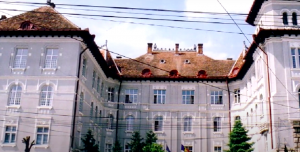
The building of the Institute for the Blind in Cluj designed by Alfred Hajós. It still functions as a school for the blind in Romanian.
The very accurate inventory of the institute’s teaching staff was also kept. Between 1900 and 1914, the institute spent about 8.526 crowns on school supplies (341.040 lei, or 25.578.000 ft.). It does not include school supplies, musical instruments, and other useful didactic or daily use items.
The library of the institute was already world famous in the 1910’s. The teachers’ library consisted mainly of constantly updated special education, typology, methodological and didactic publications, official publications of the Ministry of Religion and Public Education (so-called “guides”), which provided a model and model for teachers and educators, but also other pedagogical and psychological also books, periodicals and periodicals. There were also interesting works of art and uniqueness in the library, such as the outstanding works of Alexander Mell, Jenő Ranschburg, Helén Keller, Károly Herodek, “Annual Reports and Notices” sent from fraternal institutions, which were valuable source materials. In addition, the teacher library has ordered a number of local and national dailies. We know from the descriptions of the contemporary Western European sister institutions that the National Institute of the Blind, supported by the State-funded National Institute of the Blind, was very remarkable, unique and famous in both quality and number.
This unique spiritual wealth was carried out into the courtyard by the owners of the new regime in the early 1950s and simply set on fire.
A XX. At the beginning of the 19th century, there was only one way to reproduce Braille books in Hungary: by handwriting (high-performance digital Braille printers are available today). There were gentlemen and women who volunteered for this task, which required great attention and patience, and did it enthusiastically for a long time. These were, for example, Olga Purjesz, Marianna Wandtner, Katalin Borosnyai, Margit Csipkés, and others. Later, the older students of the Institute of the Blind in Kolozsvár also got involved in the transcription work. Importantly, the paper used for Braille is much thicker than normal, printable paper: transcribing an average-sized, plain, plain page to Braille produces 3-4 braided pages. So a 200-page standard book in Braille averages 700 pages. In the librarians’ catalogs followed until 1914, we find more than 637 volumes and 628 booklets. The vast majority of these were also available in Braille, which required a great deal of space given the aforementioned differences between plain and Braille.
So, going back to the story, after the “tendering” of 1913, which was won by the design office headed by Alfred Hajós, the construction of the new building of the institute began in 1914, but during the war they were only slow, a floor could be completed, the work stops. The building on Zápolya Street is being reserved for military purposes, where the Orthopedic Hospital, which still operates today, was opened after the Romanian takeover. The half-finished building on Honvéd Street was completed by the Romanian authorities in 1925, when education for the blind resumed, now exclusively in Romanian.
On February 23, 1933, the predecessor of the Principesa Elena (Princess Helena) Institute for Public Welfare, a long-established maternity and infant protection institute after the Romanian takeover, asked the Kolozs District Court as the land registry authority for the 1-acre and 335-square-foot property re-registration in your own name.
This transfer was made on 8 March 1938 by order No 2437. This was preceded by a very important piece of legislation: the Institute for the Blind in Kolozsvár was transferred from the Ministry of Education to the Ministry of Health. The legal status of the State-Assisted National Institute for the Blind in Kolozsvár will cease to exist, the vast wealth will be inherited and it will disappear without a trace. With the abolition of legal status, it was much easier to relocate the maternity and infant care institution to the institution for the blind, and with this and other administrative measures, all historical rights that surrounded the Institute for the Blind in Kolozsvár were abolished.
In 1914, the Institute of the Blind, as a legal entity, together with the state aid (380.000 crowns), had more than 642.000 crowns in special-purpose assets (192.600.000 forints, or 25.680.000 lei), of which 70.000 crowns were debts assumed by the state. In 1938 (or even earlier), this property disappears with a stroke of a pen.
The institute was taken over by the Romanian state in 1920, the language of instruction was changed to Romanian by the new regime with immediate effect and exclusively by the Institute for Blind in Kolzosvár (1920–1935, Institute for the Blind in Cluj-Napoca) and Aşezământul pentru Asistenţa Orbilor (Institution for the Blind). For four years after its liberation in 1940, it was named the State Institute for the Blind, and in 1945 it regained its pre-1940 name. Between 1951 and 1958, Şcoala Specială de Orbi (Special School for the Blind), from 1958 to 1978 Şcoala Medie Specială pentru Orbi (Special High School for the Blind), then Şcoala Generală Specială pentru Orbi (Special Primary School for the Blind). Since 1990, Liceul pentru De fi cienţi de Vedere (High School for the Visually Impaired) has been the name.
Following the second Viennese decision, in the 11 liberated counties administrators were instructed to list blind and partially sighted children and young people (what a luxury and how much Hungarian virtue that the army at the time was dealing with visually impaired children!). According to statistics compiled by the military headquarters, there were 52 six- and twelve-year-old, 38 thirteen- and eighteen-year-old boys and girls, and there were 31 blind boys in the institute for the blind. These are a total of 121 six- to eighteen-year-old blind boys and girls, and no data are available for young people over 18 years of age. The National Association for the Protection of the Blind is reactivating, and the obligations and rights enshrined in the contracts between the Association and the Ministry of Education have been re-established. In the post-liberation period, the previous legal status of the institute could not be regained due to Hungarian (sometimes contradictory) regulations, but the education of the blind was resumed.
The urgent economic, political and moral reconstruction of the country did not provide enough energy to restore the old legal status of the School for the Blind in Kolozsvár legally and administratively.
The Romanian school administration after 1945 disappeared, threw away, burned and destroyed the old official Hungarian-language documents, together with a huge library of curious and invaluable textbooks. Thank goodness, no effective work was done, even in the 1980’s, documents could be found in the backyards of the institute that were still readable. Some of the information described here is also derived from documents that have not been completely destroyed.
The Transylvanian Association for the Hungarian Visually Impaired is working to resume special Hungarian-language education for blind and partially sighted children in Transylvania. We are convinced that the community of the visually impaired in Transylvania with a profession, a degree and a perspective will be able to organize a cultural, economic and civic self-organization of a quality that can be an exemplary lifestyle for all visually impaired people.
If you also agree with this aspiration, support our work and goals, the future of Hungarian visually impaired children and young people in Transylvania, Partium and Banská Bystrica at the link below.
This year, the possibility of mother tongue education for them has disappeared for 101 years.
Don’t let it stay that way!


